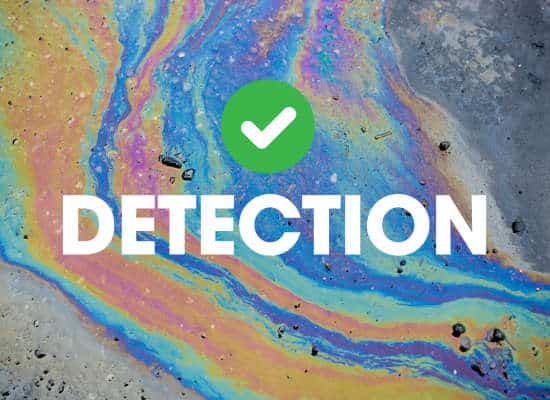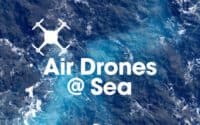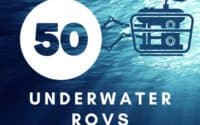Next-Gen Guardians: The Emerging Role of ROVs in Oil Spills

Underwater drones (ROVs), are transforming the maritime industry. These tools are invaluable for deep-sea missions, surveillance, and maintenance tasks that are too risky or inaccessible for humans. One of their standout roles is in managing environmental hazards, especially oil spills.
* Please send feedback/suggestions to editor @ shipuniverse.com
A Closer Look at Oil Spill Response
Oil spills are major environmental disasters that can wreak havoc on marine ecosystems and cost billions in damages. Quick and effective action is crucial. This article delves into how underwater drones are reshaping the detection and containment of oil spills, offering faster and more precise responses than ever before.
Understanding Oil Spills
The Causes of Oil Spills
Oil spills happen for various reasons. Sometimes it’s a technical failure at an oil rig, other times a ship collision or a pipeline leak. Natural calamities like hurricanes can also cause significant damage to oil infrastructure, leading to spills. The outcome is always the same: harmful oil enters and damages the marine environment.
Where Oil Spills Often Occur
Oil spills tend to happen near busy oil shipping routes, around drilling sites, and at export terminals. Many of these areas are close to critical marine habitats, putting delicate ecosystems at risk of severe damage.
The Damage Done by Oil Spills
When oil spills into the ocean, it coats everything, harming or even killing marine life. This oil can affect everything from large sea mammals to tiny plankton, disrupting food chains and damaging breeding grounds. The cleanup from an oil spill can take a very long time, with some effects lingering for years.
How We’ve Handled Oil Spills Until Now
Traditionally, spotting an oil spill involved direct sightings from ships or planes, supplemented by satellites and radar. Managing spills has involved a mix of physical barriers like booms, chemical treatments to break down the oil, and sometimes even controlled burning to remove oil from the water’s surface.
The Role of Underwater Drones in Oil Spill Detection
Underwater drones are revolutionizing how we detect oil spills, making the process quicker and more precise. Here’s how these sophisticated tools are applied in the field:
How Underwater Drones Work
Equipped with advanced technologies, underwater drones dive deep into the ocean to inspect areas where oil spills are suspected. Operating remotely, they send real-time data back to surface ships or shore-based teams, allowing for immediate analysis. This rapid deployment can be crucial in the early stages of a spill.
Did You Know? Blueye ROVs can be deployed in under 2 minutes and equipped with advanced water testing technology.
Technologies Powering Underwater Drones
- Sensors: These are the primary tools in detecting oil. Some sensors analyze water samples directly for hydrocarbons, the main components of oil, signaling the presence of a spill.
- Cameras: High-resolution cameras capture detailed images of the water and seabed, helping operators spot oil sheens and other signs of spills.
- Sonar: Sonar technology uses sound waves to detect oil under the water’s surface or buried in sediments, places where it’s difficult for other technologies to reach.
Advantages Over Traditional Methods
- Speed: Underwater drones can be deployed rapidly and cover large areas much faster than surface vessels or aerial surveillance.
- Accuracy: The sensors and cameras on these drones provide precise and accurate data, reducing the chance of false positives and ensuring that response efforts are directed correctly.
- Depth Capabilities: Unlike surface-based methods, ROVs can operate at significant depths, reaching areas that are typically inaccessible to human divers or surface equipment. This capability is crucial for deep-water oil exploration sites and deep-sea pipelines.
Enhancing Oil Spill Response with Integrated Technologies on Ships
Ship-based oil spill detection and response benefit greatly from the integration of underwater drones (ROVs) with other cutting-edge technologies. Here’s how ships are using these combined tools to improve their capabilities in managing oil spills:
Satellite Imagery and ROVs from Ships
- How It Works: Ships equipped with satellite communication tools can receive alerts and imagery from satellites that detect oil sheens on the ocean’s surface. Once a potential spill is identified, ROVs are deployed directly from the ship to the affected area to gather precise underwater data and validate the satellite’s observations.
- Benefits: This integration allows ship crews to quickly pinpoint and respond to spills. Satellite imagery offers rapid, wide-area detection, and ROVs provide detailed verification and analysis, making the response more targeted and effective.
- Example: Ships operating in the Arctic rely on satellite data to navigate and monitor environmental hazards, including oil spills. ROVs on these ships can be quickly launched to assess and address any detected oil release, crucial in remote and sensitive environments.
Coordination with Aerial Drones
- How It Works: Ships can deploy aerial drones to provide an immediate visual assessment of the area surrounding a detected spill. These drones can capture video and photos and are sometimes equipped with sensors to detect hydrocarbons. The data collected helps in deciding the deployment of ROVs for a closer, sub-surface investigation.
- Benefits: Aerial drones enable ships to extend their response reach quickly and efficiently, providing a broader view that complements the detailed insights gathered by ROVs.
- Example: During oil spill response operations, ships frequently use aerial drones to scout the spill’s extent before sending ROVs to undertake detailed sub-surface analysis, ensuring a comprehensive response strategy.
Integration with Ship-based Environmental Monitoring Systems
- How It Works: Many ships are outfitted with environmental monitoring systems that include sensors designed to detect changes in water quality or the presence of hydrocarbons. When anomalies are detected, ROVs are deployed to confirm and assess these findings.
- Benefits: Continuous monitoring on ships allows for early detection of oil spills, and the immediate deployment of ROVs can provide crucial early data. This helps in quickly understanding the spill’s scope and initiating appropriate containment measures.
- Example: Oil tankers and other vessels that transport or work with petroleum products often have fixed sensors onboard that monitor for hydrocarbon levels in the water, using ROVs to investigate any detected anomalies swiftly.
Regulatory and Safety Considerations
Legal and Safety Standards for ROV Use
The deployment of underwater drones (ROVs) in oil spill detection and response is governed by a complex web of international and national regulations. These standards ensure that the use of ROVs does not harm marine environments and complies with safety protocols to protect human operators and marine life.
- Maritime Safety Regulations: ROVs must adhere to maritime safety standards that govern their design, maintenance, and operational procedures. These standards are crucial for preventing accidents during deployment.
- Environmental Laws: Environmental regulations dictate how ROVs can be used in sensitive ecological zones. For instance, operations must minimize disturbances to marine habitats and avoid interference with protected species.
Impact of Compliance on Operational Protocols
Compliance with these regulations affects how ships and their crews prepare and execute ROV operations. This includes:
- Training Requirements: Crews operating ROVs must receive specialized training not only in handling the equipment but also in understanding the legal and environmental implications of their activities.
- Operational Restrictions: There are often specific restrictions on where and how ROVs can be deployed, especially in protected marine areas or during sensitive times for wildlife.
- Documentation and Reporting: Detailed logs of ROV deployments and findings must be maintained as part of regulatory compliance, which can be crucial for audits and inspections.
Future Directions and Innovations
Emerging Technologies in ROV Design
The field of underwater drones is rapidly advancing, with new technologies enhancing their effectiveness in detecting and responding to oil spills.
- Autonomous Operations: The next generation of ROVs is moving towards greater autonomy with the integration of artificial intelligence (AI). These advancements allow ROVs to make real-time decisions during a mission, potentially identifying and reacting to oil spills without direct human input.
- Enhanced Sensors: Innovations in sensor technology are continuously improving the sensitivity and accuracy of ROVs. These new sensors can detect smaller concentrations of oil and other chemicals, allowing for earlier detection and a more nuanced response.
- Increased Depth and Endurance: Technological improvements are also enabling ROVs to operate at greater depths and for longer durations without requiring human intervention, which is crucial for monitoring deep-sea oil drilling sites and underwater pipelines.
Predictions for Future Applications
As ROV technology continues to advance, their role in environmental protection will likely expand. Predicted developments include:
- Integrated Response Systems: ROVs will increasingly be part of integrated systems that combine surface vessels, aerial drones, and satellite technologies, offering a comprehensive monitoring and response network.
- Preventative Monitoring: With their enhanced capabilities, ROVs will be used more proactively to monitor infrastructure integrity and prevent spills before they occur, particularly in high-risk areas like aging offshore oil platforms or under-maintained pipelines.
- Advanced Data Analysis: The integration of big data analytics and machine learning with ROV operations will improve the predictive capabilities of oil spill detection systems, enabling more precise and timely responses.
These future directions not only reflect technological innovation but also a shift towards more sustainable and responsible management of marine resources, with ROVs at the forefront of minimizing environmental impacts from oil spills.
Additional References
- National Oceanic and Atmospheric Administration (NOAA) – Provides resources on the latest technology in oil spill response and environmental monitoring. NOAA’s Office of Response and Restoration
- Environmental Protection Agency (EPA) – Offers guidelines and regulations concerning environmental response to oil spills. EPA Oil Spills Prevention and Preparedness Regulations
- Bureau of Safety and Environmental Enforcement (BSEE) – Shares information on offshore regulatory programs that include the use of ROVs for oil spill response and safety compliance. BSEE Technology Assessment and Research
- International Maritime Organization (IMO) – Details international regulations and preparedness for oil spill prevention and response. IMO Pollution Prevention and Response
- The Marine Spill Response Corporation (MSRC) – Provides information on spill response services and the integration of technology in spill management. Marine Spill Response Corporation
- Oil Spill Prevention and Response Advisory Group (OSPRAG) – Offers insights into innovations and advancements in oil spill response technologies. OSPRAG Reports and Publications
- International Oil Pollution Compensation Funds (IOPC Funds) – Discusses compensation and preventive measures related to oil pollution damage. IOPC Funds Publications and Documents
- World Wildlife Fund (WWF) – Oil Spill Response Techniques – Explains the environmental impact of oil spills and the role of technology in mitigating these effects. WWF on Oil Spill Prevention and Response

Do you have a Maritime Product or Service that may be of interest to Shipowners? Tell us about it here!
Do you have feedback or insights? Please reach out to editor @ shipuniverse.com



